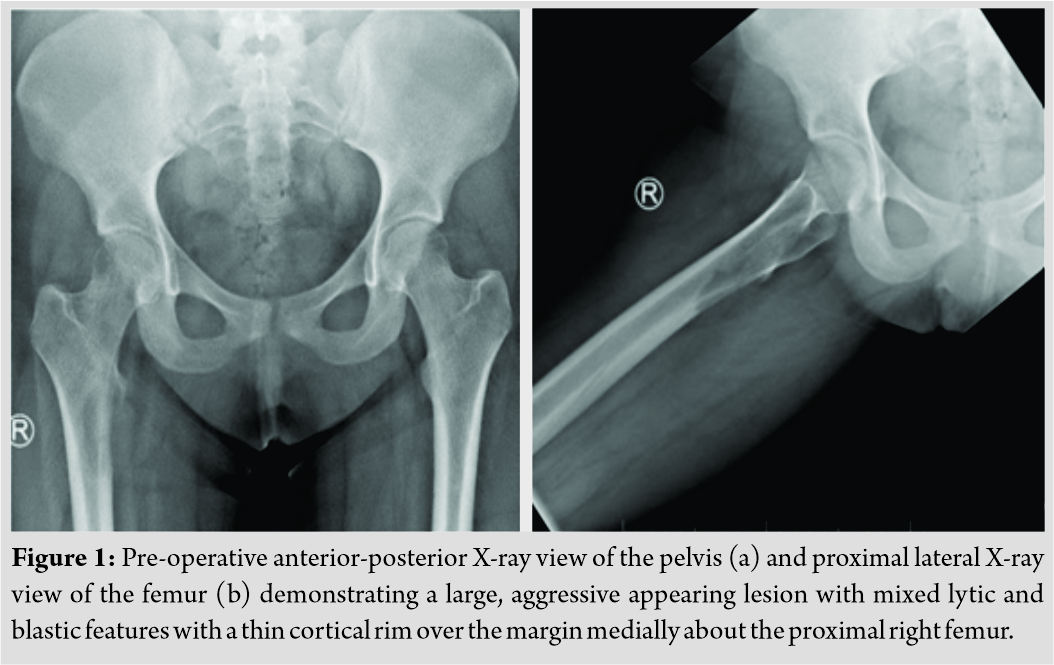[box type=”bio”] Learning Point of the Article: [/box]
Epithelioid osteoblastoma is a very rare entity that can be difficult to differentiate from osteosarcoma and requires an experienced pathologist for correct diagnosis.
Case Report | Volume 9 | Issue 5 | JOCR September – October 2019 | Page | 74-77 | Alan T Blank, Connor Wakefield, Mazdak Khalighi, Kevin B Jones, R Lor Randall. DOI: 10.13107/jocr.2019.v09i05.1542
Authors: Alan T Blank[1], Connor Wakefield[1], Mazdak Khalighi[2], Kevin B Jones[3], R Lor Randall[4]
[1]Department of Orthopedic Surgery, Division of Oncology, Rush University Medical Center, Chicago, Illinois, United States,
[2]Department of Pathology, University of Utah, Salt Lake City, Utah, United States,
[3]Department of Orthopedics, University of Utah, Salt Lake City, Utah, United States,
[4]Department of Orthopaedic Surgery, University of California, Davis, Sacramento, California, United States.
Address of Correspondence:
Dr. Alan T Blank,
Department of Orthopedic Surgery, Rush University Medical Center, 1611 W. Harrison St, Suite 300, Chicago, IL 60612, United States.
Email: alan.blank@rushortho.com
Abstract
Introduction: Epithelioid osteoblastomas are an extremely rare entity infrequently seen in the resection of benign bone tumors. First described in the early 20thcentury, it has only been reported a handful of times throughout literature. Although these tumors can present similarly to malignant bone lesions, it is important for an experienced pathologist to differentiate epithelioid osteoblastoma from osteosarcoma. We present the case and treatment of a young female who was discovered to have an epithelioid osteoblastoma of the femur.
Case Report: We describe the case of a 19-year-old healthy female who presented with 3 weeks of progressive right-sided groin pain. After biopsy demonstrated, epithelioid osteoblastoma extensive curettage of the lesion followed by insertion of a short cephalomedullary intramedullary nail was performed. At 1-year follow-up,the patient was full weight-bearing without pain or recurrence.
Conclusion: Epithelioidosteoblastomas are a very rare entity in the diagnosis of benign bone tumors and are characterized as having aggressive features clinically, radiographically, and histologically. It is imperative that an experienced pathologist differentiates this lesion from osteosarcoma to guide treatment and to ensure the best possible outcomes.
Keywords: Epithelioidosteoblastoma, benign bone tumor, proximal femoral nail.
Introduction
Osteoblastomas account for around 1% of benign bone tumors diagnosed on tissue pathology[1]. Since they are so rarely diagnosed, the exact incidence is unknown. The lesion was first reported by Jaffe and Mayer, in 1932,who described osteoblastoma involving the metacarpalbone[2]. Since thisfirst description, a number of case series have been published characterizing this benign bone-forming neoplasm[1, 3, 4, 5].However, due to the relative infrequency, in which this lesion is diagnosed, large series are difficult to establish. Perhaps, the largest series, published by Lucas et al., found that osteoblastomas were more common in malesand most often diagnosed in the vertebral column and sacrum [4]. Osteoblastoma can present a diagnostic challenge to providers as there can be considerable overlap in presentation with other bony tumors. It is most important to exclude osteosarcoma when there is a suspicion of osteoblastoma. There are distinguishing features between osteoblastoma and osteosarcoma that can aid in the correct diagnosis. Clinically, it is very difficult to differentiate the two as both can present similarly. Osteoblastoma often presents with significant deep pain associated with both activity and rest typically unrelieved with anti-inflammatory medications [6]. Radiographically, osteoblastoma can appear as an aggressive well-circumscribed, radiolucent mass that has the potential to grow quite large [7]. Other findings on radiography include the presence of athin cortical margin and central mineralization [8]. In contrast, osteosarcoma is commonly associated with destructive features on radiography such as periosteal reaction, presence of Codman’s triangles, and loss of nearby host cortical bone [7]. Furthermore, osteosarcoma almost always has an irregular lesion-host interface [9, 10]. Histopathologic evaluation of osteoblastoma will show poorly organizedvascularosteoid patterns with trabeculae lined by osteoblasts [3, 11].The presence of pleomorphism or active mitosis should be concerning for a malignant process, such as osteosarcoma, and can help the pathologist differentiate the two entities [8, 9, 11, 12]. Due to these radiographic and histopathologic findings, scrutiny must be used when differentiating between osteoblastoma and osteosarcoma.
Further, complicating the diagnostic challenge is the spectrum of lesions found in osteoblastoma. More aggressive forms of osteoblastoma lesions contain epithelioid osteoblasts[3]. This finding has led some pathologists to sub classify osteoblastomas based on these findings as Stage 1 (quiescent), Stage 2 (active), or Stage 3 (aggressive or epithelioid), with Stage 3 among the rarest of the subtypes [3]. In this lesion, epithelioid-appearing osteoblasts appear to rim the bony architecture of the lesion and can be organized into sheets[4]. This report discusses the case of a patient with an epithelioid osteoblastoma of the proximal femur treated with open curettage, bone grafting, and internal fixation.
Case Report
History
A 19-year-old healthy female presented to the musculoskeletal oncology clinic with a chief complaint of the right-sided groin pain for 3 weeks. The pain was progressive in nature and atraumatic in origin. The patient noted significant pain with functional activity in addition to nighttime pain. Oral anti-inflammatory medications did not relieve the pain completely.
Radiographic features
Radiographs were obtained by her primary care provider, which demonstrated a large, aggressive lesion with some mixed lytic and blastic features about the proximal femur (Fig. 1). On careful examination, there appeared to be a thin cortical rim over the margin of the lesion medially. Magnetic resonance imaging was obtained and demonstrated an aggressive appearing lesion centered near the inferomedial femoral neck as well as the lesser trochanter (Fig. 2). The lesion demonstrated a lytic appearance with some extension through the cortex. A soft tissue mass of approximately 6cm in size was present which abutted the iliopsoas and vastus musculature causing adjacent mass effect.
Intervention
The patient underwent an open biopsy of the lesion through a posterolateral approach to the proximal femur. Sections from the curettage specimen showed a proliferation of relatively uniform large polygonal cells with eccentric round nuclei and abundant eosinophilic cytoplasm (Fig. 3). These cells were associated with the formation of new woven bone and seen growing in large sheets. By immunohistochemistry, the cells showed diffuse positive staining for SATB2, consistent with osteoblastic differentiation. Tumor necrosis was not present and mitotic activity was low (1–3 mitotic figures per 10 high-power fields). Overall, the morphologic features were consistent with an epithelioid osteoblastoma. After a diagnosis of epithelioid osteoblastoma was established, the patient returned to the operating room for extensive curettage of the lesion through a posterolateral approach followed by insertion of a short cephalomedullary intramedullary nail. Before insertion of the nail, an argon beam was used to ablate the curettage bony and soft tissue margin. Following insertion of the nail, the defect was then filled with allograft cancellous bone as well as demineralized bone matrix and the wound was then closed. The patient was made partial weight-bearing for a period of 6 weeks followed by full weight-bearing. Her pain was reported to be significantly relieved at the 6-week post-operative visit and she was ambulating with a mildly antalgic gait. One year post-operative imaging did not reveal any hardware complications or lesion recurrence (Fig. 4). In addition, on examination at the 1-year post-operative follow-up,the patient was not limited in gait or function. We will continue to follow the patient with serial radiographs and physical examinations for years to evaluate for recurrence.
Discussion
Osteoblastoma is a rare entity accounting for 1% of all benign bone tumor diagnoses [3]. Patients with osteoblastoma often present with significant pain and an aggressive appearing lesion on imaging. This lesion most frequently occurs in male adolescents and young adults and is commonly seen in the long bones or posterior spinal elements [1]. It is common for patients to report nighttime pain and incomplete pain relief with anti-inflammatory medications. This can be a differentiating factor from another benign bone tumor, osteoid osteoma, which responds well to anti-inflammatory medications [6]. Epithelioid osteoblastoma is a rare variant of osteoblastoma that has been reported to account for as little as 14% of all osteoblastomas [3]. Epithelioid osteoblastoma can present with particularly aggressive clinical, radiographic, and histopathologic features. Due to these similar features, it can be particularly challenging to differentiate these lesions from malignant lesions such as osteosarcoma. Clinically, the patient reported symptoms at presentation cannot differentiate between osteoblastoma and osteosarcoma. However, progressive symptoms or new findings during initial workup should be concerning for a malignant process. Radiographic and histologic findings of both lesions can aid in the correct diagnosis. On radiography, osteoblastomas and osteosarcoma can have some overlap making diagnosis challenging. Osteoblastoma is often described as well-circumscribed lesions, with round well-defined contours, associated with expansive growth [10]. In contrast, osteosarcoma is more frequently associated with more severe destructive features, notably aggressive periosteal reaction. Aggressive periosteal reaction can be characterized as spiculated, or lamellated, in appearance with the possibility to form Codman’s triangles [10].Finally, osteosarcoma almost always has an irregular lesion-host interface, with loss of surrounding cortical bone, which can greatly aid in differentiating the two [9]. Perhaps, histologic assessment is most important in differentiating osteoblastoma from osteosarcoma. Osteoblastoma is characterized as having a sharp lesion interface with the absence of infiltration into surrounding normal bone [10]. In contrast, osteosarcoma has been found to frequently be associated with nearby bony lesion infiltration andthe presence of an irregular shaped lesion interface [10,13]. Furthermore, alack of pleomorphic cells,mitotic activity, and tumor permeation taken together strongly favor the diagnosis of osteoblastoma over osteosarcoma [5, 11, 12].
As epithelioid osteoblastoma can be locally aggressive, extensive curettage or en bloc resection is the preferred treatment method [8]. For this case, intramedullary fixation was also necessary to reduce the risk of post-operative fracture as the lesion had cortical bone destruction and was localized to an anatomic area at high risk for pathologic fracture. Even with seemingly adequate resection, local recurrence rates have been documented from 10 to 20% [3]. Although these lesions have never been documented to metastasize, there have been cases of patient mortality from locally aggressive osteoblastoma tumors of the central neuroaxis [4]. There have also been few cases of secondary malignant transformation of osteoblastoma to osteosarcoma [14, 15, 16]. However, it is always possible that these cases were initially misdiagnosed.
Conclusion
Epithelioid osteoblastoma is an extremely rare entity among the benign bone tumors encountered. With only a handful of cases reported within literature, it is important to have an appreciation and understanding of these rare tumors to ensure the correct diagnosis. It is imperative an experienced pathologist differentiate sepithelioid osteoblastoma from osteosarcoma as both share, particularly aggressive features on histopathology. Differentiating epithelioid osteoblastoma from malignant bone lesions is crucial to ensure correct patient treatment and the best possible patient outcome.
Clinical Message
Correctly diagnosing epithelioid osteoblastoma can be difficult due to the clinical, radiographic, and histologic similarities, it shares with osteosarcoma. Although epithelioid osteoblastoma is benign, it can still present in an aggressive nature with localized symptoms. A pathologist experienced with identifying bone tumors is required to evaluate these lesions.
References
1. Berry M, Mankin H, Gebhardt M, Rosenberg A, Hornicek F. Osteoblastoma: A 30-year study of 99 cases. J Surg Oncol 2008;98:179-83.
2. Jaffe H, Mayer L. An osteoblastic osteoid tissue-forming tumor of a metacarpal bone. Arch Surg 1932;24:550-64.
3. Della Rocca C, Huvos AG. Osteoblastoma: Varied histological presentations with a benign clinical course. An analysis of 55 cases. Am J Surg Pathol1996;20:841-50.
4. Lucas DR, Unni KK, McLeod RA, O’Connor MI, Sim FH. Osteoblastoma: Clinicopathologic study of 306 cases. Hum Pathol 1994;25:117-34.
5. ZonFilippi R, Swee RG, Krishnan Unni K. Epithelioid multinodular osteoblastoma: A clinicopathologic analysis of 26 cases. Am J Surg Pathol2007;31:1265-8.
6. Frassica FJ, Waltrip RL, Sponseller PD, Ma LD, McCarthy EF Jr. Clinicopathologic features and treatment of osteoid osteoma and osteoblastoma in children and adolescents. Orthop Clin North Am 1996;27:559-74.
7. Ozger H, Alphan B, Soylemez MS, Ozkan K, Salduz A, Bilgic B, Sirin BK. Clinical management of a challenging malignancy, osteoblastoma-like osteosarcoma: A report of four cases and a review of literature. Ther Clin Risk Manag2016;12:1261-70.
8. Britt JD, Murphey MD, Castle JT. Epithelioid osteoblastoma. Head Neck Pathol 2012;6:451-4.
9. Edeiken-Monroe B, Edeiken J, Jacobson HG. Osteosarcoma. SeminRoentgenol1989;24:153-73.
10. Rosado KE, Pitt MJ, Siegal GP. Osteoblastoma: A mimic of osteosarcoma. PediatrPathol Mol Med 2000;19:305-22.
11. Dorfman HD, Weiss SW. Borderline osteoblastic tumors: Problems in the differential diagnosis of aggressive osteoblastoma and low-grade osteosarcoma. Semin Diagn Pathol1984;1:215-34.
12. Deyrup AT, Monson DK, Dorfman HD. Aggressive (epithelioid) osteoblastoma arising in soft tissue. Int J Surg Pathol2008;16:308-10.
13. Bertoni F, Unni KK, McLeod RA, Dahlin DC. Osteosarcoma resembling osteoblastoma. Cancer 1985;55:416-26.
14. Merryweather R, Middlemiss JH, Sanerkin NG. Malignant transformation of osteoblastoma. J Bone Joint Surg Br 1980;62:381-4.
15. Woźniak AW, Nowaczyk MT, Osmola K, Golusinski W. Malignant transformation of an osteoblastoma of the mandible: Case report and review of the literature. Eur Arch Otorhinolaryngol2010;267:845-9.
16. Kraft CT, Morrison RJ, Arts HA. Malignant transformation of a high-grade osteoblastoma of the petrous apex with subcutaneous metastasis. Ear Nose Throat J 2016;95:230-3.
 |
 |
 |
 |
 |
| Dr. Alan T Blank | Dr. Connor Wakefield | Dr. Mazdak Khalighi | Dr. Mazdak Khalighi | Dr. R Lor Randall |
| How to Cite This Article: Blank A T, Wakefield C, Khalighi M, Jones K B, Randall R L. Epithelioid Osteoblastoma of the Proximal Femur in a 19-Year-Old Female: A Case Report and Review of Literature. Journal of Orthopaedic Case Reports 2019 Sep-Oct;9(5): 74-77. |
[Full Text HTML] [Full Text PDF] [XML]
[rate_this_page]
Dear Reader, We are very excited about New Features in JOCR. Please do let us know what you think by Clicking on the Sliding “Feedback Form” button on the <<< left of the page or sending a mail to us at editor.jocr@gmail.com







